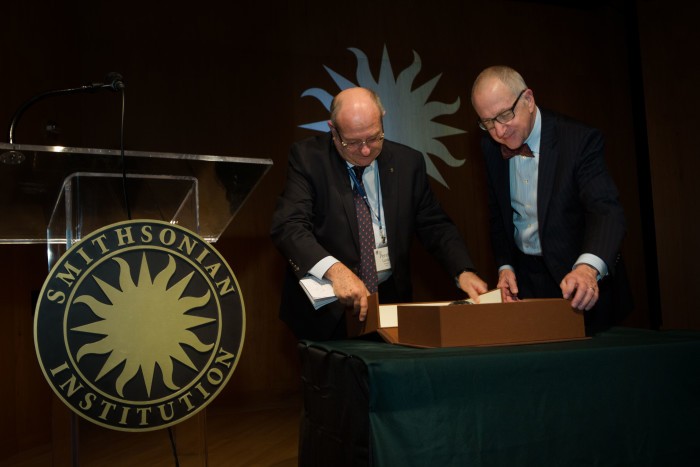Technion Nano Bible to Smithsonian
October 30, 2015
By Kevin Hattori
In a special ceremony held this afternoon at the Smithsonian’s National Museum of History in Washington, D.C., President Peretz Lavie, of the Technion-Israel Institute of Technology, presented Smithsonian Secretary David J. Skorton with a Nano Bible, the world’s tiniest version of the Old Testament.
The Nano Bible – the first in the United States – will become part of the Smithsonian Libraries collection, housed in the Dibner Library of the History of Science and Technology at the National Museum of American History.
Conceived and created by Prof. Uri Sivan and Dr. Ohad Zohar of the Russell Berrie Nanotechnology Institute at the Technion, in Haifa, Israel, the Nano Bible is engraved on a gold-plated silicon chip the size of a sugar grain. Its text consists of more than 1.2 million letters carved with a focused beam of gallium ions, and must be magnified 10,000 times to be readable. At less than 100 atoms thick, the Nano Bible demonstrates how people can process, store and share data through tiny dimensions using nanotechnology.
“The Technion is delighted to give this Nano Bible to the Smithsonian Libraries,” said Technion President, Professor Peretz Lavie. “The Nano Bible is a fascinating confluence of history, culture and cutting-edge science, making it, I believe, a perfect fit for inclusion in the Dibner Library of the History of Science and Technology.”

Technion President Prof. Peretz Lavie (left) presents Smithsonian President David Skorton with the Technion Nano Bible
The term “nano” derives from the Greek word nanos, meaning “dwarf.” The unit nanometer measures one billionth of a meter, a ratio similar to the size of an olive compared to the entire planet Earth. Nanotechnology makes it possible to construct new materials stronger and lighter than steel, to desalinate water more efficiently, to deliver medications to designated parts of the body without harming surrounding tissues, and to detect cancerous cells in early stages. At the dawn of the nano age, scientists and engineers are discovering ways to harness such exquisite control over the elementary building blocks of nature for the benefit of mankind and our planet.
“We are excited to enrich the Libraries’ collections with this marvelous gift, which marries one of the world’s oldest and most significant texts with one of the newest technologies of the 21st century,” said Nancy E. Gwinn, director of Smithsonian Libraries. “As one of our principal values is to share our collections with the public, it is appropriate that the only copy in the United States be located here, as part of the national collections.”
The Russell Berrie Nanotechnology Institute
The Russell Berrie Nanotechnology Institute aims at positioning the Technion and the State of Israel at the forefront of global nanotechnology research and development. Vigorous recruitment of bright new faculty from research labs around the world, extensive investment in infrastructure, new educational programs for training the next generation of scientists and engineers, and nurturing of multidisciplinary collaborations within campus, as well as with industry and other academic institutions, provide the vehicle for achieving the desired impact on Technion, the State of Israel, and the well being of mankind. The Russell Berrie Nanotechnology Institute includes over 150 faculty members and 300 graduate students and post-doctorate fellows from 14 different faculties.



